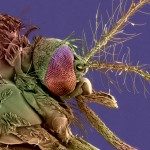Lien vers Pubmed [PMID] – 23437397
PLoS ONE 2013;8(2):e57548
Emergence of arboviruses could result from their ability to exploit new environments, for example a new host. This ability is facilitated by the high mutation rate occurring during viral genome replication. The last emergence of chikungunya in the Indian Ocean region corroborates this statement since a single viral mutation at the position 226 on the E1 glycoprotein (E1-A226V) was associated with enhanced transmission by the mosquito Aedes albopictus in regions where the major mosquito vector, Aedes aegypti, is absent.We used direct competition assays in vivo to dissect out the mechanisms underlying the selection of E1-226V by Ae. albopictus. When the original variant E1-226A and the newly emerged E1-226V were provided in the same blood-meal at equal titers to both species of mosquitoes, we found that the proportion of both variants was drastically different in the two mosquito species. Following ingestion of the infectious blood-meal, the E1-226V variant was preferentially selected in Ae. albopictus, whereas the E1-226A variant was sometimes favored in Ae. aegypti. Interestingly, when the two variants were introduced into the mosquitoes by intrathoracic inoculations, E1-226V was no longer favored for dissemination and transmission in Ae. albopictus, showing that the midgut barrier plays a key role in E1-226V selection.This study sheds light on the role of the midgut barrier in the selection of novel arbovirus emerging variants. We also bring new insight into how the pre-existing variant E1-226V was selected among other viral variants including E1-226A. Indeed the E1-226V variant present at low levels in natural viral populations could rapidly emerge after being selected in Ae. albopictus at the midgut barrier level.
